
Vivat Academia. Revista de Comunicación. 2017, junio-septiembre, nº 139, 53-66 ISSN: 1575-2844 doi: https://doi.org/10.15178/va.2017.139.53-66

![]()
![]()
Perspectivas de los estudiantes sobre el uso de redes sociales en el proceso educativo superior
Universities in Mexico are incorporating technology to carry out the educational activities. In fact, professors identify and select the tools and communication applications that enable the development of skills in the students. In particular, this piece of research through the quantitative approach analyzes the impact of using the social network Facebook in the educational context. The sample consists of 19 students who are studying Business Management and Information Technology at a university in Mexico City. The measuring instrument is composed of 12 questions about attention, usefulness, learning and motivation in using Facebook during the 2016-1 school year. Finally, this piece of research establishes that social networks improve communication and facilitate the assimilation and use of knowledge.
Higher Education – Technology – Social Networking – Facebook – Teaching – Learning – New technologies
![]()
1 Ricardo Adán Salas Rueda: Doctor of Design of New Technologies Autonomous Metropolitan University (UAM) in the year 2014. For 13 years he has taught several courses at the undergraduate and postgraduate level in Mexico. Candidate for national researcher by the National System of Researchers (SNI).
![]()
53
Las universidades en México están incorporando la tecnología durante la realización de las actividades educativas. De hecho, los docentes identifican y seleccionan las herramientas informáticas y aplicaciones de comunicación que permitan el desarrollo de las competencias en los estudiantes. En particular, esta investigación por medio del Enfoque cuantitativo analiza el impacto de utilizar la red social Facebook en el contexto educativo. La muestra está compuesta por 19 alumnos que cursan la Licenciatura en Gestión de Negocios y Tecnologías de Información en una universidad ubicada en la Ciudad de México. El instrumento de medición consta de 12 preguntas sobre la atención, la utilidad, el aprendizaje y la motivación al utilizar Facebook durante el ciclo escolar 2016-1. Por último, esta investigación afirma que las redes sociales mejoran la comunicación y facilitan la asimilación y el uso del conocimiento.
Educación Superior – Tecnología – Redes sociales – Facebook – Enseñanza - Aprendizaje –
Nuevas tecnologías
As universidades no México estão incorporando a tecnologia durante a realização das atividades educativas. De fato, os docentes identificam e selecionam as ferramentas informáticas e aplicações de comunicação que permitam o desenvolvimento das competências nos estudantes. Em particular, esta investigação por meio do Enfoque quantitativo analisa o impacto de utilizar a rede social Facebook no contexto educativo. A amostra esta composta por 19 alunos que cursam a Licenciatura em Gestão de Negócios e Tecnologias de Informação em uma universidade localizada na Cidade do México. O instrumento de medição consta de 12 perguntas sobre a atenção, a utilidade, a aprendizagem e a motivação ao utilizar Facebook durante o ciclo escolar 2016-1. Por ultimo, esta investigação afirma que as redes sociais melhoram a comunicação e facilitam a assimilação e o uso do conhecimento.
Educação Superior – Tecnologia – Redes Sociais – Facebook – Ensinamentos – Aprendizagem – Novas Tecnologias.
54
Today, the activities and responsibilities of teachers and students in the classroom are changing due to the incorporation and use of technology in teaching-learning (González, Tornel and Jimenez, 2014; Reigeluth, 2012). In fact, the role of teachers is being transformed and adapted to the demands and needs of the 21st Century Society, causing the emergence of facilitators (Reigeluth, 2012). Even college students are actively involved in the educational process through IT tools and communication applications (González, Tornel and Jimenez, 2014).
It is noteworthy that distance education has evolved over generations: correspondence teaching, multimedia teaching and telematics education (García, 1999; Simonson, Smaldino, Albright and Zvacek, 2012). These technological changes have made higher education institutions to recognize the importance of social networks as innovative teaching-learning mechanisms (Valerio, Herrera, Villanueva, Herrera and Rodriguez, 2015).
It is worth mentioning that "the use of network tools not explicitly designed for learning has great potential. As long as teachers know the different platforms and tools that the network provides, we can use with our students "(Martinez, 2014, p. 275). Hence distance education allows us to create learning experiences through the use of telecommunication systems (Simonson, Smaldino, Albright and Zvacek, 2012).
In particular, the use of social tools enables information sharing and encourages the creation of appropriate scenarios for the dissemination of knowledge (Altinay, Saner, Bahcelerli and Altinay, 2016). According to Huang, Wu, She and Lin (2014), Facebook and MySpace are the most popular methods of distance communication among web users. The origin of the use of social networks in the educational context is linked to the Web 2.0 tools (Ersoy and Güneyli, 2016; Huang, Yang, Huang and Hsiao, 2010).
Also Rojas (2014, p. 9) explains that "the use of high-tech devices is inherent in the daily activities of college students. Through social networking systems, especially Facebook, such devices become the meeting point of the network of friends and direct and indirect contacts." Similarly, Olarte, Dominguez, Elizondo and Garcia (2014) emphasize the importance of using the social network Facebook during the teaching-learning process to achieve development and autonomy of students. Therefore, there is a need to promote the use of social networks at universities (Gallardo, Marquis and Bullen, 2015). With this background in mind, this piece of research aims to analyze the impact of using the social network Facebook in a university located in Mexico City during the teaching-learning process related to computer science.
The general objective of this piece of research is to analyze and evaluate the impact of using the social network Facebook during the teaching-learning process related to computer science. The variables used in this study are attention, usefulness, learning and motivation.
The methodology used in this piece of research is based on the quantitative approach to analyze the impact of using the social network Facebook during the higher education process. The sample consists of 19 students pursuing a degree in Business Management and Information Technology at a university in Mexico City.
In this study, the social network Facebook is used as a means of dissemination, delivery and
discussion of two activities about computer science. In the first activity (theoretical), students use this social network to share the answers to three questions related to building web
55
systems. During the second activity, students have the source code and the output screens for the development of software.
Through Descriptive Statistics, variables on care, usefulness, learning and motivation to use the social network Facebook in the educational context were analyzed and evaluated. Table 1 shows the research instrument, which uses as scale: Strongly Agree (1) Agree (2) Neither agree nor disagree (3) Disagree (4) and Strongly disagree (5).
Table 1.
Measurement instrument.
No | Variable | Question |
1 | Attention | Facebook caught my attention |
The organization of information used in Facebook helped me keep my attention. | ||
The variety of content used in Facebook helped me keep my attention. | ||
2 | Usefulness | Using Facebook is interesting. |
When I joined Facebook I thought it would be easy to use. | ||
I enjoyed the course content through Facebook. | ||
3 | Learning | While using Facebook I was sure that I would learn. |
Good organization of Facebook allowed me to be confident that I can learn. | ||
The contents and structure of Facebook are easy to understand. | ||
4 | Motivation | I would like to learn more about the topic discussed on Facebook. |
I am satisfied with the use of the social network Facebook. | ||
There was content on Facebook that showed me that this material may be important to others. |
Source: Made by the authors.
Below are the results on the variable "Attention" to questions 1, 2 and 3 of the questionnaire. Figure 1 shows the results for Question 1: Facebook caught my attention. The highest percentage corresponds to category Agree with 47.37%.
56

Figure 2 shows the results for Question 2: The organization of information used in Facebook helped me keep my attention. The category neither agree nor disagree is more preferred with 36.84%. The category Agree ranks second with 31.58%.

Figure 3 shows the results for Question 3: The variety of content used in Facebook helped me keep my attention. There is a large percentage of students (68.42%) who are located in the category Agree.
57
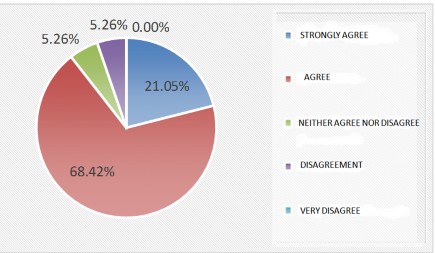
Below are the results on the variable "Usefulness" to questions 4, 5 and 6 of the questionnaire.
Figure 4 shows the results for Question 4: The use of Facebook is interesting. The
categories Strongly agree and Agree have the acceptance rate of 42.11%.

Figure 5 shows the results for Question 5: When I joined Facebook I thought it would be easy to use. 47.37% of respondents believe that this social network is easy to use. Similarly, 31.58% of students are located in the category Agree.
58

Figure 6 shows the results for Question 6: I enjoyed the course content through Facebook. 47.37% of students believe they enjoy teaching and learning process.
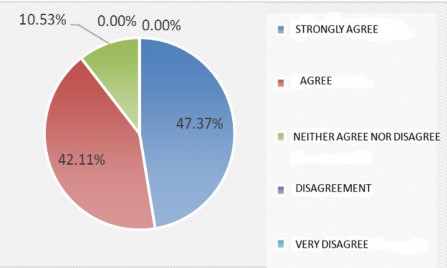
Below are the results on the variable "Learning" to questions 7, 8 and 9 of the questionnaire.
Figure 7 shows the results for Question 7: While using Facebook I was sure that I
would learn. The highest percentage of acceptance is located in category strongly Agree with 42.11%.
59
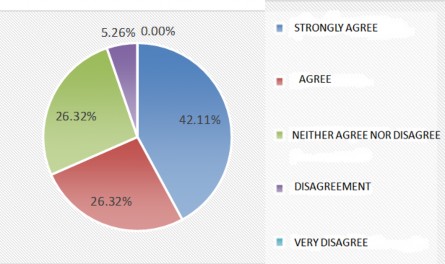
Figure 8 shows the results for Question 8: Good organization of Facebook allowed me to be confident that I can learn. Regarding this aspect, categories and Strongly Agree and Neither agree nor disagree obtained the highest percentage with 36.84%.
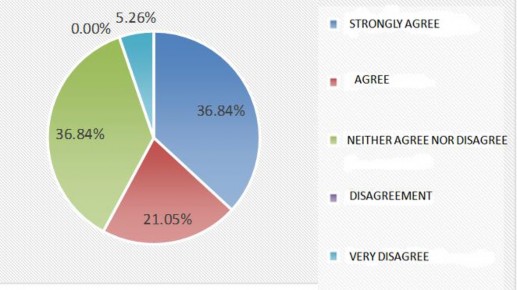
Figure 9 shows the results for Question 9: The contents and structure of Facebook are easy to understand. Most preferably lies in the category Strongly agree with 73.68%
60

Below are the results on the variable "Motivation" for questions 10, 11 and 12 of the questionnaire.
Figure 10 shows the results for Question 10: I would like to learn more about the
topic discussed on Facebook. 57.89% of students are in the category of Agree on the need to learn more about the contents.
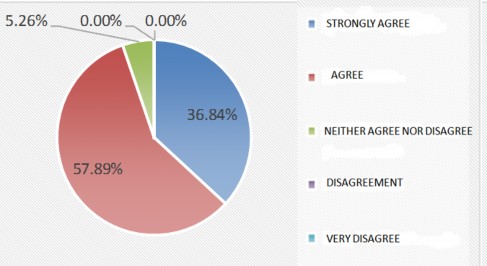
Figure 11 shows the results for Question 11: I am satisfied with the use of the social network Facebook. 47.37% of students feel comfortable to use this network and it is located in the category Strongly agree. Similarly, 42.11% of users are in the category Agree.
61
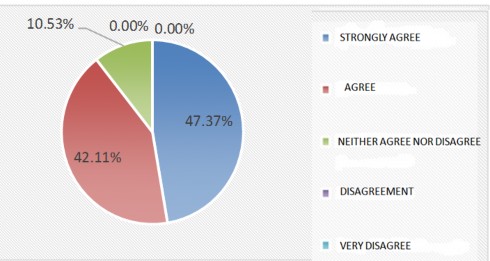
Figure 12 shows the results for Question 12: There was content on Facebook that showed me that this material may be important to others. 47.37% of students are in the category Strongly agree and 42.11% are in the category Agree.
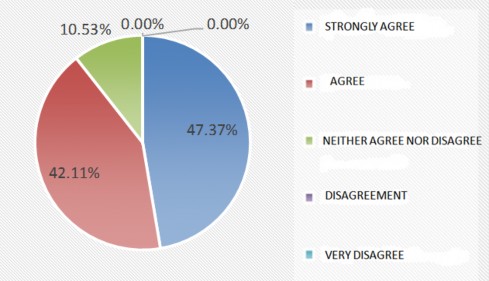
Table 2 shows the percentage frequency for variables Attention, Usefulness, Learning and Motivation for the use of the social network Facebook.
62
Table 2.
Percentage frequency of the variables used in this study.
No | Answers | Attention | Usefulness | Learning | Motivation |
1 | Strongly agree | 29 825% | 45 614% | 50 877% | 43 860% |
2 | Agree | 49,123% | 38,596% | 24,561% | 47,368% |
3 | Neither agree nor disagree | 14,035% | 10,526% | 21,053% | 8,772% |
4 | Disagree | 7.018% | 5.263% | 1.754% | 0.000% |
5 | Strongly disagree | 0.000% | 0.000% | 1.754% | 0.000% |
The advances in technology related to computer tools and communication applications require those responsible for the teaching-learning process to plan and organize new strategies for assimilation of knowledge and development of skills in students (Ellis, 2016; Paiva Morais, Costa & Pinheiro, 2016; Taddeo & Barnes 2016; Vuopala, Hyvönen & Jarvela, 2016).
The distance education system is comprised of technology; learning, teaching, course design and policy management (Moore and Kearsley, 2012). In particular, "social networking systems allow a more personal and human connection motivating other platforms" (Rojas, 2014, p. 1).
One of the advantages of the social network Facebook for users of the web is the ability to share information, photos, videos and messages (Llorens and Capdeferro, 2011; Pimmer, Linxen & Gröhbiel, 2012).
In this piece of research, the impact of using Facebook for the higher education process on computer science considering the variables Attention, Usefulness,
Learning and Motivation is analyzed. It is worth mentioning that 42% of students are in the category Strongly agree on this social network that caught their attention. Similarly, 47.37% of students say they thought it would be easy to use (variable Usefulness). On the other hand, the variable Learning about the fact that the contents and structure of the social network Facebook are easy to understand acquires 73.68% of acceptance among users. Also 47% of students are very satisfied to use this social network during the teaching-learning process (variable Motivation).
It is noteworthy that the highest percentage frequency for category Strongly agree is
represented by the variable Learning with 50.87%, followed by the variable Usefulness (45.61%), Motivation (43.86%) and Attention (29.82%).
Finally, social networks represent a technological alternative in the 21st Century that
improves the current conditions of the educational process through collaboration and reflection of participants (Demirbilek, 2015; Lin, Hu, Hu & Liu, 2016; Magogwe, Ntereke & Phetlhe, 2015; Scott, 2013).
63
Altinay, Z.; Saner, T.; Bahcelerli, N. M. & Altinay, F. (2016). The Role of Social Media Tools: Accessible Tourism for Disabled Citizens. Educational Technology & Society, 19(1), 89–99.
Demirbilek, M. (2015). Social media and peer feedback: What do students really think about using Wiki and Facebook as platforms for peer feedback? Active Learning in Higher Education, 16, 211-224. doi:10.1177/1469787415589530
Ellis, A. (2016). Qualitatively different university student experiences of inquiry: Associations among approaches to inquiry, technologies and perceptions of the learning environment. Active Learning in Higher Education, 17, 13-23, doi:10.1177/1469787415616721
Ersoy, M. & Güneyli, A. (2016). Social Networking as a Tool for Lifelong Learning with Orthopedically Impaired Learners. Educational Technology & Society, 19(1), 41– 52.
Gallardo, E.; Marqués, L. & Bullen, M. (2015). El estudiante en la educación superior: Usos académicos y sociales de la tecnología digital. Universities and Knowledge Society Journal, 12(1). 25-37. doi:dx.doi.org/10.7238/rusc.v12i1.2078
García Aretio, L. (1999). Historia de la educación a distancia. Revista Iberoamericana de Educación a Distancia, 2(1), 8-27.
González Ortiz, J. J.; Tornel Abellán, M. & Jiménez Hernández, D. (2014). La enseñanza virtual y los métodos activos en educación superior, en J. F. Durán Medina, & I. Durán Valero, (Eds.), La era de las TIC en la nueva docencia (pp. 199- 210). Madrid: McGraw Hill Education.
Huang, T. Y.; Wu, H. L.; She, H. C. & Lin, Y. R. (2014). Enhancing Students’ NOS Views and Science Knowledge Using Facebook-based Scientific News. Educational Technology & Society, 17 (4), 289–301.
Huang, J. J. S.; Yang, S. J. H.; Huang, Y. M. & Hsiao, I. Y. T. (2010). Social Learning Networks: Build Mobile Learning Networks Based on Collaborative Services. Educational Technology & Society, 13 (3), 78–92.
Lin, X.; Hu, X.; Hu, Q. & Liu, Z. (2016). A social network analysis of teaching and research collaboration in a teachers' virtual learning community. British Journal of Educational Technology, 47, 302–319. doi:10.1111/bjet.12234
Llorens, F. & Capdeferro, N. (2011). Posibilidades de la plataforma Facebook para el aprendizaje colaborativo en línea. Revista de Universidad y Sociedad del Conocimiento,
8(2), 31-45.
64
Magogwe, J. M.; Ntereke, B. & Phetlhe, K. R. (2015). Facebook and classroom group work: A trial study involving University of Botswana Advanced Oral Presentation students. British Journal of Educational Technology, 46, 1312–1323. doi:10.1111/bjet.12204
Martínez Rivera, O. (2014). Modelos de enseñanza y aprendizaje en la Universidad: Redes sociales y aplicaciones móviles para la generación de trabajos en grupo, en J.
F. Durán Medina, & I. Durán Valero, (Eds.), La era de las TIC en la nueva docencia
(pp. 267-290). Madrid: McGraw Hill Education.
Moore, M. & Kearsley, G. (2012). Distance education: A systems view of online learning.
California: Cengage Learning.
Olarte Larrea, J. J.; Domínguez Pérez, C.; Elizondo, A. J. & García Izquierdo, F. J. (2014). Incorporado Facebook como herramienta de apoyo en los trabajos de fin de grado de ingeniería informática, en J. F. Durán Medina, & I. Durán Valero, (Eds.), La era de las TIC en la nueva docencia (pp. 351-362). Madrid: McGraw Hill Education.
Paiva, J.; Morais, C.; Costa, L. & Pinheiro, A. (2016). The shift from e-learning to learning: Invisible technology and the dropping of the “e”. British Journal of Educational Technology, 47, 226–238. doi:10.1111/bjet.12242
Pimmer, C.; Linxen, S. & Gröhbiel, U. (2012). Facebook as a learning tool? A case study on the appropriation of social network sites from mobile phones in developing countries. British Journal of Educational Technology, 43, 726–738. doi: 10.1111/j.1467-8535.2012.01351.x
Reigeluth, C. M. (2012). Instructional theory and technology for the new paradigm of education. Revista de Educación a Distancia, 32, 1-18.
Rojas Kramer, C. A. (2014). Uso de Facebook en ámbitos educativos universitarios: consideraciones y recomendaciones. Revista Apertura, 6(2), 1-12.
Scott, K. M. (2013). Does a university teacher need to change e-learning beliefs and practices when using a social networking site? A longitudinal case study. British Journal of Educational Technology, 44, 571–580. doi:10.1111/bjet.12072
Simonson, M.; Smaldino, S.; Albright, M. & Zvacek, S. (2012). Teaching and Learning at a Distance. Foundations of Distance Education. Nueva York: Pearson.
Taddeo, C. & Barnes, A. (2016). The school website: Facilitating communication engagement and learning. British Journal of Educational Technology, 47, 421–436. doi:10.1111/bjet.12229
65
Valerio, G.; Herrera Murillo, D.; Villanueva, F.; Herrera Murillo, N. & Rodríguez Martínez, M. C. (2015). Relación entre los formatos de publicación y el engagement digital: estudio de las páginas de Facebook de las universidades mexicanas. Universities and Knowledge Society Journal, 12(1), 50-54.
doi:dx.doi.org/10.7238/rusc.v12i1.1887
Vuopala, E; Hyvönen, P. & Jarvela, S. (2016). Interaction forms in successful collaborative learning in virtual learning environments. Active Learning in Higher Education, 17, 25-38. doi:10.1177/1469787415616730
Doctor in Design of New Technologies, graduated from the Autonomous Metropolitan University (UAM). For 13 years he has taught several courses at undergraduate and graduate levels. Candidate to national researcher by the National Research System (SNI). Head of Research Group "Usable Systems" at La Salle University.
http://orcid.org/0000-0002-6689-4460
Secondary education teacher of Automotive Mechanics. Civil engineer. Master of Planning. Master of Finance. For 16 years he taught in junior high school. He was director for 8 years in junior high and high school (particular). He worked at ISEC University for 23 years at High level, bachelor's degree and master’s degree and at La Salle University for 21 years at the undergraduate level. https://www.researchgate.net/researcher/2107256668_Jose_Luis_Lugo_Garcia
He is currently a student of Management Business and Information Technologies at La Salle University. He attends the 6th semester of his bachelor’s degree while working in a financial institution in the area of application development, focusing on the use and implementation of ETL tools, addressing specific requirements from different internal users. He has a broad interest in the area of Big Data, data analysis and business intelligence, so he agreed to participate in the development of this study in order to gain experience in this field and develop his knowledge in his areas of interest.
66